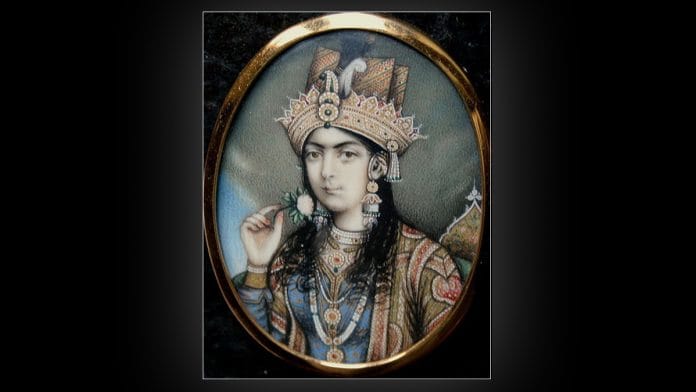Nur Jahan was the only Mughal empress who had coins minted with her name on them. She also saved her husband Jehangir from the clutches of rebel leader Mabahat Khan.
New Delhi: Nur Jahan, the twentieth wife of Mughal emperor Jehangir, was a woman of remarkable strength and courage. She wielded such great power that she often presided the court alongside Jehangir and took part in matters of the state.
Early life
Born as Mehr-un-Nissa to a Persian noble family on 31 May, 1577 in Kandahar in present-day Afghanistan, Nur was the fourth child of Mirza Ghias Beg and Asmat Begam. Author Indu Sundaresan, in her book The Twentieth Wife, describes her as a child with captivating beauty:
“Azure blue eyes looked up at Asmat and dimpled smile broke out on her face, showing perfectly even, white teeth with one gap in the front where a permanent tooth was yet to come.”
Nur mastered Arabic and Persian languages and studied arts, literature, music and dance.
In 1594, at the age of 17, she married Sher Afghan Khan, a soldier in the Mughal army. The couple’s daughter, Ladli Begum, was born in 1605. The tumultuous marriage, said to be arranged by emperor Akbar himself, ended in 1607 with Sher Afghan’s death.
Marriage to Jehangir
It is said that Jehangir, emperor Akbar’s son, fell for Nur Jahan even before her marriage with Sher Afghan Khan ended. According to some accounts, he had a role in Nur’s first husband’s death, but there is no evidence to confirm these stories. After the death of her husband, Nur and Ladli Begum were summoned to the court in Agra to act as ladies-in-waiting to the dowager empress Ruqaiya Sultan Begum.
In 1611, Jehangir met Nur Jahan, then 34, in the palace bazaar where he proposed marriage to her. After their wed, Jehangir gave her the title of Nur Jahan, meaning ‘light of the world’. While Nur was devoted to Jehangir, he too held great affection for Nur and trusted her with the affairs of the state.
Also read: How Mughal Empire’s most powerful woman tried to keep man behind Taj Mahal from his throne
An empress who managed court affairs
According to historians, Nur Jahan was often seen in the jharokhas receiving the audience and issuing orders, sometimes without Jehangir. Due to his addiction to opium and alcohol, Jehangir was often missing from court proceedings, which made it easier for Nur to assert her authority. Such power in the hands of an empress at a time when women were kept under veil was a novelty.
Nur Jahan was the only Mughal empress who had coins minted with her name on them. An ace marksman, she was also seen hunting tigers with her husband. Known for her shrewd planning and physical strength, Nur Jahan was able to rescue Jehangir from the clutches of rebel leader Mabahat Khan in 1626.
After Jehangir’s death in October 1627, his son from Rajput princess Jagat Gosaini, Prince Shah Jahan, took over the reins and Nur Jahan was forced to live in a mansion in Lahore along with her daughter. During this period, she oversaw the completion of Itmad-ud-daulah, a mausoleum which would later prove to be the inspiration for the Taj Mahal in Agra. Nur Jahan died on 17 December, 1645 at the age of 68.
While the Taj Mahal is seen as an eternal symbol of love, made by Shah Jahan for his wife Mumtaz Mahal, their love story was, according to historians, tailored by none other than Nur Jahan herself. Mumtaz was Nur Jahan’s niece and was married to Shah Jahan when she was 19.
Also read: Jahangir’s true love was not Anarkali but alcohol







Mughal emperors did only destruction of Hindus Monuments, Scripts,Looted Khazanas their wives, convert them to Islam, It Was TejoMahalaya not Taj mahal, it was not built by shah jahan, Tejo Mahalaya is Shiva Temple not Mumtaj Maqbara.
You have not either mentioned or not aware of her first marriage and life. Yes she married to Sher Afgan in Burdwan, West Bengal. He has died while fighting with Qutubudding [general of Jehangir] along with Qutubuddin. Both people’s grave are there at Khakkarsaheb, Burdwan. Jehangir sent Qutubuddin to take Nur Jahan away from her husband who was Tahasildar of Burdwan.
Not only that once she saved life of Father of Bandel church from death sentence by Jehangeer.
This article depicts irrelevant history, not culture. Life of Muslim kings and their concubine, internecine conflicts, killing of father, son, brother apart from promiscuity, luxury is not culture of a society. And it’s not Indian. The Muslim Invaders did nothing good for Bharat, but looted or enjoyed its wealth, apart from destroying the valuable books, manuscripts, knowledge base and scientific thinking in the subcontinent. Only cultural benefit from them was architecture, which also emanated from Bharatiya / Gandhara style.
According to our studies, saleem
is called as jahangir and நூர்ஜஹான் is his firstwife. anarkali is his lover